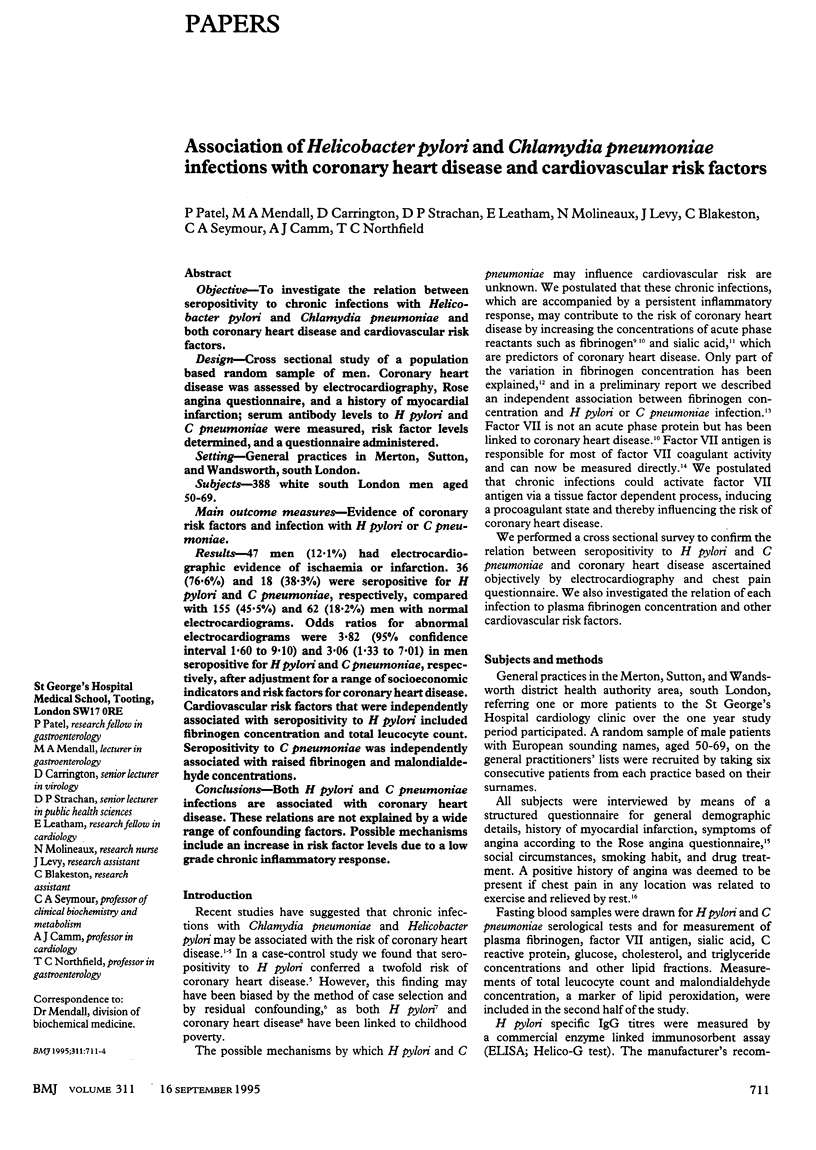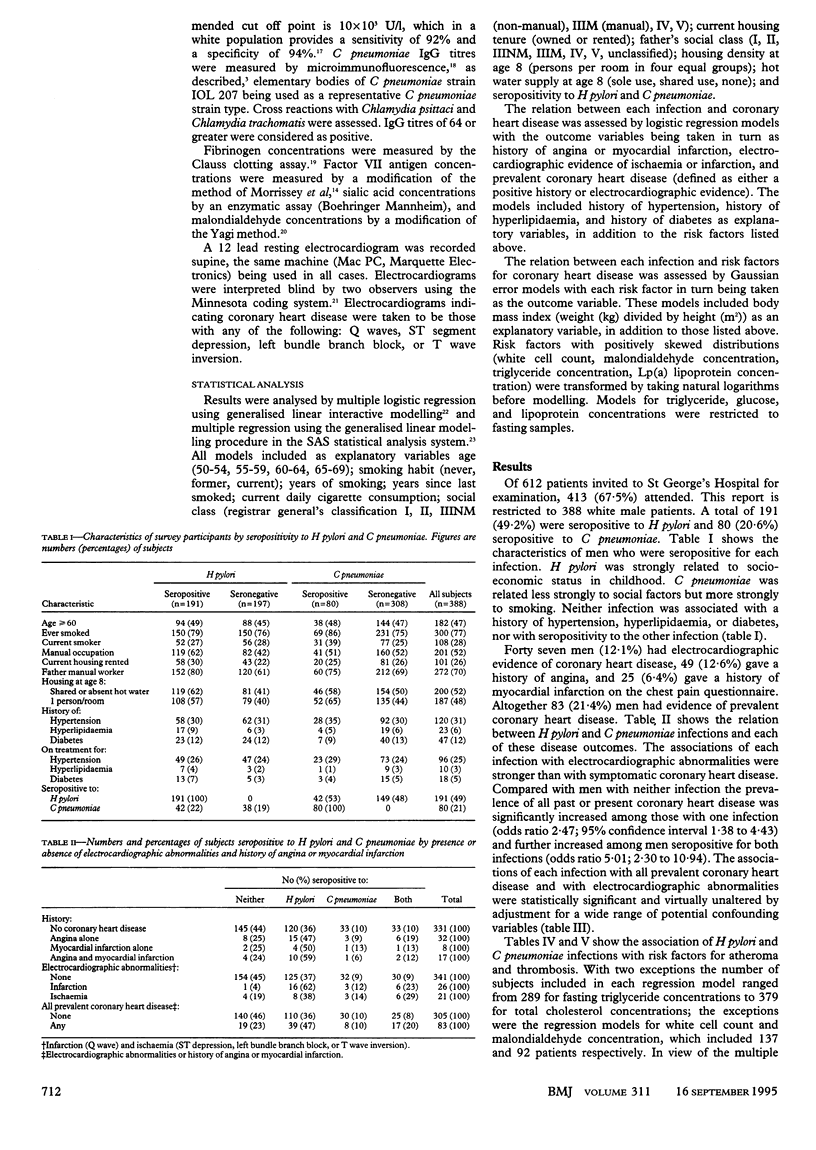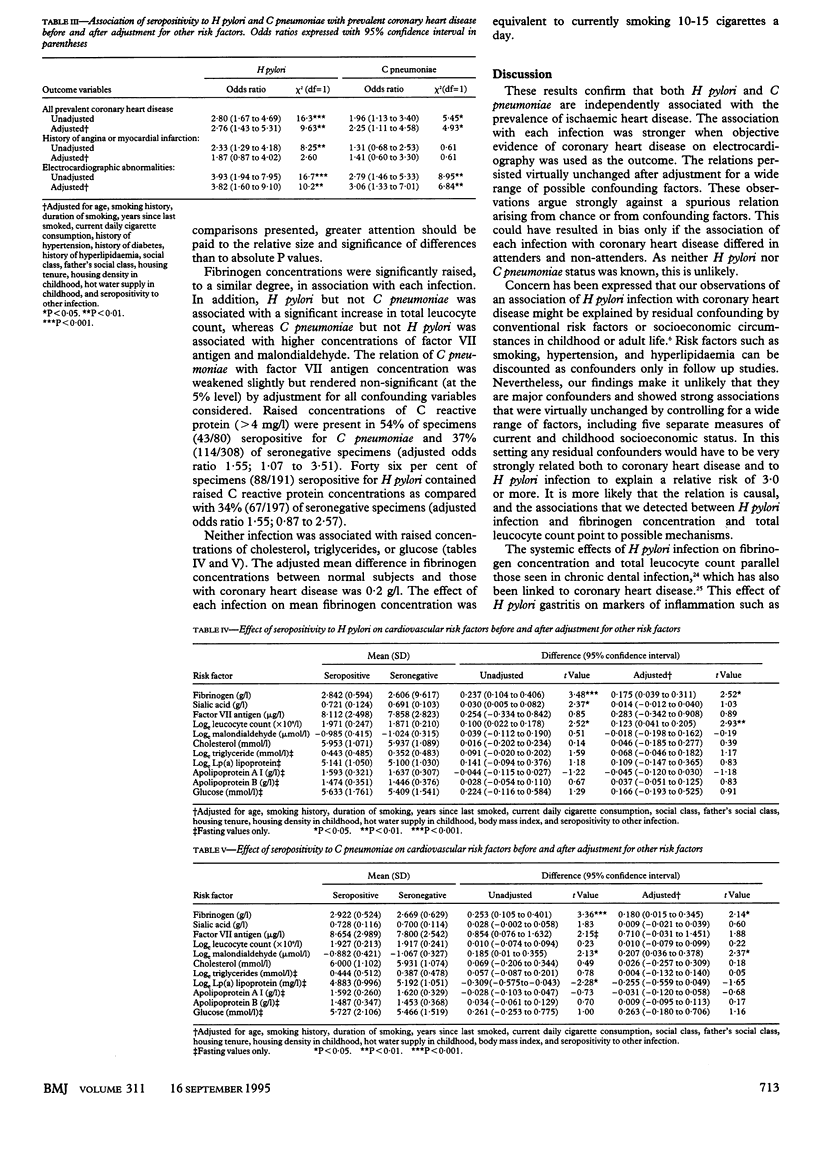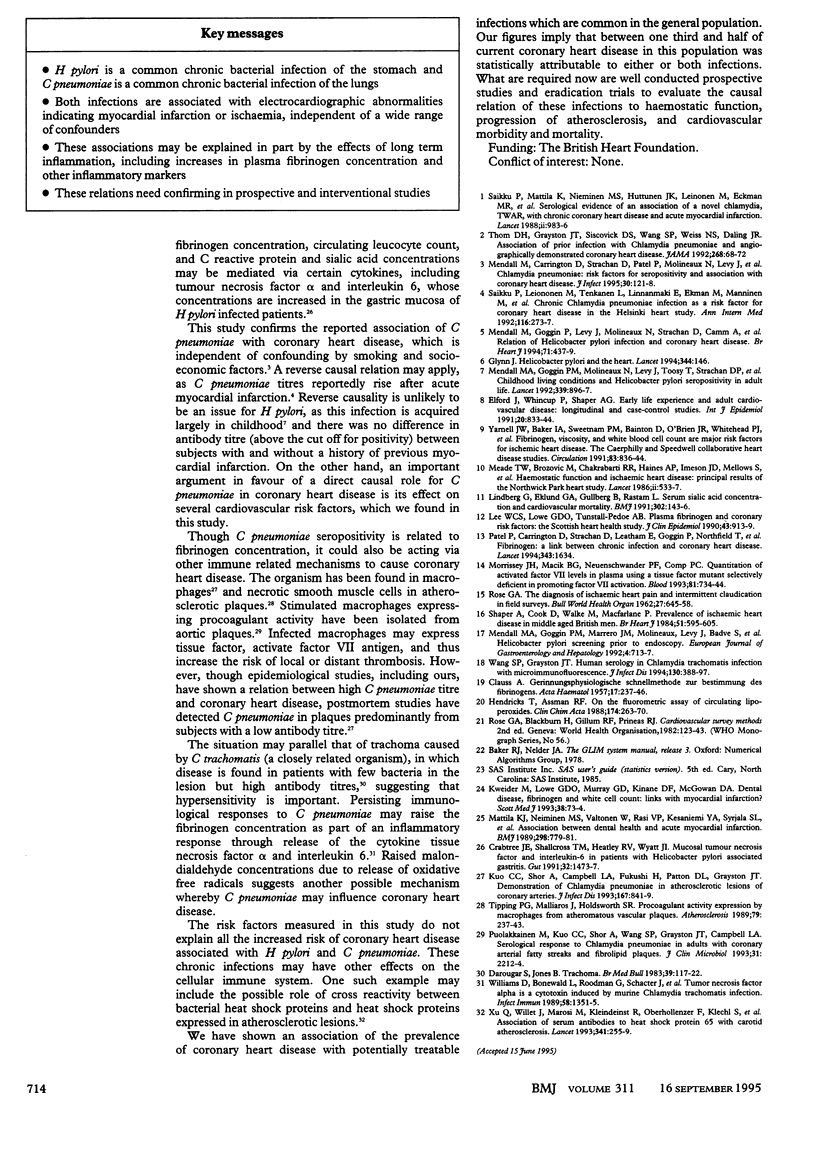Abstract
OBJECTIVE--To investigate the relation between seropositivity to chronic infections with Helicobacter pylori and Chlamydia pneumoniae and both coronary heart disease and cardiovascular risk factors. DESIGN--Cross sectional study of a population based random sample of men. Coronary heart disease was assessed by electrocardiography, Rose angina questionnaire, and a history of myocardial infarction; serum antibody levels to H pylori and C pneumoniae were measured, risk factor levels determined, and a questionnaire administered. SETTING--General practices in Merton, Sutton, and Wandsworth, south London. SUBJECTS--388 white south London men aged 50-69. MAIN OUTCOME MEASURES--Evidence of coronary risk factors and infection with H pylori or C pneumoniae. RESULTS--47 men (12.1%) had electrocardiographic evidence of ischaemia or infarction. 36 (76.6%) and 18 (38.3%) were seropositive for H pylori and C pneumoniae, respectively, compared with 155 (45.5%) and 62 (18.2%) men with normal electrocardiograms. Odds ratios for abnormal electrocardiograms were 3.82 (95% confidence interval 1.60 to 9.10) and 3.06 (1.33 to 7.01) in men seropositive for H pylori and C pneumoniae, respectively, after adjustment for a range of socioeconomic indicators and risk factors for coronary heart disease. Cardiovascular risk factors that were independently associated with seropositivity to H pylori included fibrinogen concentration and total leucocyte count. Seropositivity to C pneumoniae was independently associated with raised fibrinogen and malondialdehyde concentrations. CONCLUSIONS--Both H pylori and C pneumoniae infectins are associated with coronary heart disease. These relations are not explained by a wide range of confounding factors. Possible mechanisms include an increase in risk factor levels due to a low grade chronic inflammatory response.
Full text
PDF



Selected References
These references are in PubMed. This may not be the complete list of references from this article.
- CLAUSS A. Gerinnungsphysiologische Schnellmethode zur Bestimmung des Fibrinogens. Acta Haematol. 1957 Apr;17(4):237–246. doi: 10.1159/000205234. [DOI] [PubMed] [Google Scholar]
- Crabtree J. E., Shallcross T. M., Heatley R. V., Wyatt J. I. Mucosal tumour necrosis factor alpha and interleukin-6 in patients with Helicobacter pylori associated gastritis. Gut. 1991 Dec;32(12):1473–1477. doi: 10.1136/gut.32.12.1473. [DOI] [PMC free article] [PubMed] [Google Scholar]
- Elford J., Whincup P., Shaper A. G. Early life experience and adult cardiovascular disease: longitudinal and case-control studies. Int J Epidemiol. 1991 Dec;20(4):833–844. doi: 10.1093/ije/20.4.833. [DOI] [PubMed] [Google Scholar]
- Glynn J. R. Helicobacter pylori and the heart. Lancet. 1994 Jul 16;344(8916):146–146. doi: 10.1016/s0140-6736(94)92754-5. [DOI] [PubMed] [Google Scholar]
- Kuo C. C., Shor A., Campbell L. A., Fukushi H., Patton D. L., Grayston J. T. Demonstration of Chlamydia pneumoniae in atherosclerotic lesions of coronary arteries. J Infect Dis. 1993 Apr;167(4):841–849. doi: 10.1093/infdis/167.4.841. [DOI] [PubMed] [Google Scholar]
- Kweider M., Lowe G. D., Murray G. D., Kinane D. F., McGowan D. A. Dental disease, fibrinogen and white cell count; links with myocardial infarction? Scott Med J. 1993 Jun;38(3):73–74. doi: 10.1177/003693309303800304. [DOI] [PubMed] [Google Scholar]
- Lee A. J., Smith W. C., Lowe G. D., Tunstall-Pedoe H. Plasma fibrinogen and coronary risk factors: the Scottish Heart Health Study. J Clin Epidemiol. 1990;43(9):913–919. doi: 10.1016/0895-4356(90)90075-z. [DOI] [PubMed] [Google Scholar]
- Lindberg G., Eklund G. A., Gullberg B., Råstam L. Serum sialic acid concentration and cardiovascular mortality. BMJ. 1991 Jan 19;302(6769):143–146. doi: 10.1136/bmj.302.6769.143. [DOI] [PMC free article] [PubMed] [Google Scholar]
- Mattila K. J., Nieminen M. S., Valtonen V. V., Rasi V. P., Kesäniemi Y. A., Syrjälä S. L., Jungell P. S., Isoluoma M., Hietaniemi K., Jokinen M. J. Association between dental health and acute myocardial infarction. BMJ. 1989 Mar 25;298(6676):779–781. doi: 10.1136/bmj.298.6676.779. [DOI] [PMC free article] [PubMed] [Google Scholar]
- Meade T. W., Mellows S., Brozovic M., Miller G. J., Chakrabarti R. R., North W. R., Haines A. P., Stirling Y., Imeson J. D., Thompson S. G. Haemostatic function and ischaemic heart disease: principal results of the Northwick Park Heart Study. Lancet. 1986 Sep 6;2(8506):533–537. doi: 10.1016/s0140-6736(86)90111-x. [DOI] [PubMed] [Google Scholar]
- Mendall M. A., Carrington D., Strachan D., Patel P., Molineaux N., Levi J., Toosey T., Camm A. J., Northfield T. C. Chlamydia pneumoniae: risk factors for seropositivity and association with coronary heart disease. J Infect. 1995 Mar;30(2):121–128. doi: 10.1016/s0163-4453(95)80006-9. [DOI] [PubMed] [Google Scholar]
- Mendall M. A., Goggin P. M., Molineaux N., Levy J., Toosy T., Strachan D., Camm A. J., Northfield T. C. Relation of Helicobacter pylori infection and coronary heart disease. Br Heart J. 1994 May;71(5):437–439. doi: 10.1136/hrt.71.5.437. [DOI] [PMC free article] [PubMed] [Google Scholar]
- Mendall M. A., Goggin P. M., Molineaux N., Levy J., Toosy T., Strachan D., Northfield T. C. Childhood living conditions and Helicobacter pylori seropositivity in adult life. Lancet. 1992 Apr 11;339(8798):896–897. doi: 10.1016/0140-6736(92)90931-r. [DOI] [PubMed] [Google Scholar]
- Morrissey J. H., Macik B. G., Neuenschwander P. F., Comp P. C. Quantitation of activated factor VII levels in plasma using a tissue factor mutant selectively deficient in promoting factor VII activation. Blood. 1993 Feb 1;81(3):734–744. [PubMed] [Google Scholar]
- Patel P., Carrington D., Strachan D. P., Leatham E., Goggin P., Northfield T. C., Mendall M. A. Fibrinogen: a link between chronic infection and coronary heart disease. Lancet. 1994 Jun 25;343(8913):1634–1635. doi: 10.1016/s0140-6736(94)93084-8. [DOI] [PubMed] [Google Scholar]
- Puolakkainen M., Kuo C. C., Shor A., Wang S. P., Grayston J. T., Campbell L. A. Serological response to Chlamydia pneumoniae in adults with coronary arterial fatty streaks and fibrolipid plaques. J Clin Microbiol. 1993 Aug;31(8):2212–2214. doi: 10.1128/jcm.31.8.2212-2214.1993. [DOI] [PMC free article] [PubMed] [Google Scholar]
- ROSE G. A. The diagnosis of ischaemic heart pain and intermittent claudication in field surveys. Bull World Health Organ. 1962;27:645–658. [PMC free article] [PubMed] [Google Scholar]
- Saikku P., Leinonen M., Mattila K., Ekman M. R., Nieminen M. S., Mäkelä P. H., Huttunen J. K., Valtonen V. Serological evidence of an association of a novel Chlamydia, TWAR, with chronic coronary heart disease and acute myocardial infarction. Lancet. 1988 Oct 29;2(8618):983–986. doi: 10.1016/s0140-6736(88)90741-6. [DOI] [PubMed] [Google Scholar]
- Saikku P., Leinonen M., Tenkanen L., Linnanmäki E., Ekman M. R., Manninen V., Mänttäri M., Frick M. H., Huttunen J. K. Chronic Chlamydia pneumoniae infection as a risk factor for coronary heart disease in the Helsinki Heart Study. Ann Intern Med. 1992 Feb 15;116(4):273–278. doi: 10.7326/0003-4819-116-4-273. [DOI] [PubMed] [Google Scholar]
- Shaper A. G., Cook D. G., Walker M., Macfarlane P. W. Prevalence of ischaemic heart disease in middle aged British men. Br Heart J. 1984 Jun;51(6):595–605. doi: 10.1136/hrt.51.6.595. [DOI] [PMC free article] [PubMed] [Google Scholar]
- Thom D. H., Grayston J. T., Siscovick D. S., Wang S. P., Weiss N. S., Daling J. R. Association of prior infection with Chlamydia pneumoniae and angiographically demonstrated coronary artery disease. JAMA. 1992 Jul 1;268(1):68–72. [PubMed] [Google Scholar]
- Tipping P. G., Malliaros J., Holdsworth S. R. Procoagulant activity expression by macrophages from atheromatous vascular plaques. Atherosclerosis. 1989 Oct;79(2-3):237–243. doi: 10.1016/0021-9150(89)90129-9. [DOI] [PubMed] [Google Scholar]
- Wang S. P., Grayston J. T. Human serology in Chlamydia trachomatis infection with microimmunofluorescence. J Infect Dis. 1974 Oct;130(4):388–397. doi: 10.1093/infdis/130.4.388. [DOI] [PubMed] [Google Scholar]
- Williams D. M., Bonewald L. F., Roodman G. D., Byrne G. I., Magee D. M., Schachter J. Tumor necrosis factor alpha is a cytotoxin induced by murine Chlamydia trachomatis infection. Infect Immun. 1989 May;57(5):1351–1355. doi: 10.1128/iai.57.5.1351-1355.1989. [DOI] [PMC free article] [PubMed] [Google Scholar]
- Xu Q., Willeit J., Marosi M., Kleindienst R., Oberhollenzer F., Kiechl S., Stulnig T., Luef G., Wick G. Association of serum antibodies to heat-shock protein 65 with carotid atherosclerosis. Lancet. 1993 Jan 30;341(8840):255–259. doi: 10.1016/0140-6736(93)92613-x. [DOI] [PubMed] [Google Scholar]
- Yarnell J. W., Baker I. A., Sweetnam P. M., Bainton D., O'Brien J. R., Whitehead P. J., Elwood P. C. Fibrinogen, viscosity, and white blood cell count are major risk factors for ischemic heart disease. The Caerphilly and Speedwell collaborative heart disease studies. Circulation. 1991 Mar;83(3):836–844. doi: 10.1161/01.cir.83.3.836. [DOI] [PubMed] [Google Scholar]


